#threatened species
Text



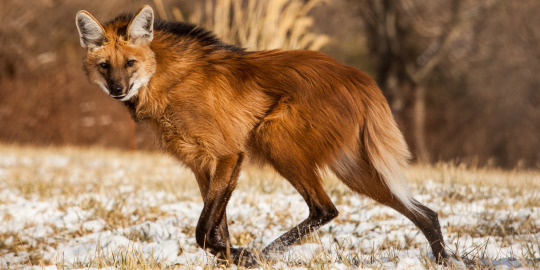


Maned Wolf photodump! Learn more about them here <3
#eee theyre so cool#I’d kinsider them if they weren’t so solitary#in fact I might anyways#maned wolf#endangered animals#threatened species#cool animal things#wolfkin#therian#foxkin#canine#maned fox
1K notes
·
View notes
Text

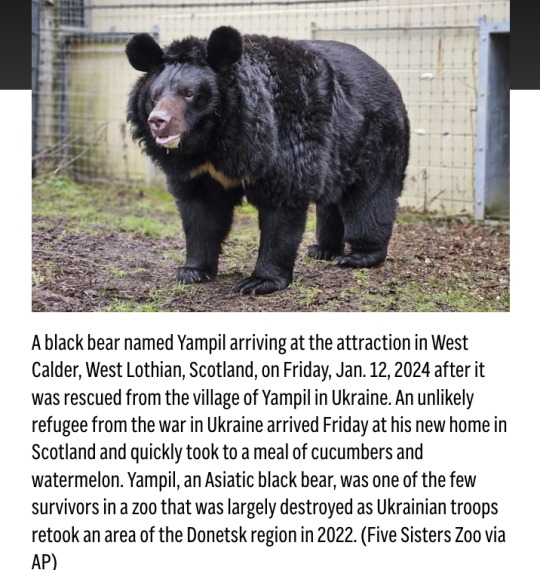
By Brian Melley, AP News
13 January 2024
LONDON (AP) — An unlikely refugee from the war in Ukraine — a rare Asiatic black bear — arrived at his new home in Scotland on Friday and quickly took to a meal of cucumbers and watermelon.
The 12-year-old Yampil was named for a village in the Donetsk region where he was one of the few survivors found by Ukrainian troops in the remains of a bombed-out private zoo.
Yampil, who had previously been called Borya, was discovered by soldiers who recaptured the devastated city of Lyman during the Kharkiv counteroffensive in the fall of 2022, said Yegor Yakovlev of Save Wild, who was among the first of many people who led the bear to a new life.
The bear was found in a menagerie that had long been abandoned by its owners.
Almost all the other animals had died of hunger, thirst or were struck by bullets or shrapnel and some were eaten by Russian troops.
Yampil narrowly missed the same fate, suffering a concussion from a projectile that landed nearby.
“The bear miraculously survived,” said Yakovlev, also director of the White Rock Bear Shelter, where the bear recovered.
“Our fighters did not know what to do with him, so they started looking for rescue.”
What followed was an odyssey that your average bear rarely makes, as he was moved to Kyiv for veterinary care and rehab, then shipped to a zoo in Poland, then to an animal rescue in Belgium, where he spent the past seven months, before landing in the United Kingdom.
Brian Curran, owner of Five Sisters Zoo in West Calder, Scotland, said his heart broke when he learned of the plight of the threatened Asiatic black bear.
“He was in terrible condition; five more days and they wouldn’t have been able to save him,” Curran said. “We were just so amazed he was still alive and well.”
The bear was skinny but not malnourished when he was found, said Frederik Thoelen, a biologist at the Nature Help Center in Belgium.
He now is estimated to weigh a healthy 440 pounds (200 kilograms), Thoelen said.
The nature center in Belgium, which usually treats injured wildlife and returns them to their natural settings, has taken several animals rescued from the war in Ukraine, including a wolf, a caracal cat and four lions, though those animals had not experienced the ordeal Yampil endured.
It was remarkable how calm Yampil was when he arrived in Belgium, Thoelen said.
The bear was trained in the past two weeks to move from his enclosure to the crate that would transport him across Belgium to Calais, France, then across the English Channel on a ferry to Scotland.
Pastries from a local bakery were used for good measure to lure him Thursday into the cage, where he was sedated for the journey.
“We want to use the food that he likes most, and for most bears — and for people also — it’s sweet, unhealthy foods,” Thoelen said.
Thoelen had a sense of the bear’s weight as he drove the crate to the port.
“Every time when we had a red light or a traffic jam, when the bear moved a little bit, you could feel the van moving also,” he said.
“You could feel it was a heavy animal in the back of the car.”
Yampil arrived at the zoo about 15 miles (25 kilometers) west of Edinburgh and immediately made himself at home.
He feasted on cukes — said to be his favorite food — and melon, said Adam Welsh, who works at Five Sisters.
The Asiatic black bear is listed on the International Union for Conservation of Nature’s Red List of Threatened Species as vulnerable to extinction in the wild, where it can be found in central and southern Asia, Russia, and Japan.
It’s known for the distinctive white crescent patch on its chest that gives it the nickname moon bear. It can live for up to 30 years in zoos.
It’s not clear if the bear will go into hibernation. The winter has been warmer than usual but colder days are on the horizon.
The zoo has other bears, but Yampil is the only Asian bear and unique in other ways.
“We’ve had circus bears, for example, that have been rescued,” Welsh said.
“We’ve had bears rescued from places like roadside restaurants where they’ve been used as kind of roadside attractions and been kept in subpar conditions. But this is the first time that we’ve worked with an animal that’s been rescued from a war zone.”
youtube
Scottish zoo welcomes black bear which survived war in Ukraine
13 January 2024
🖤🐻🤎
#Asiatic black bear#Ukraine#Scotland#Yampil#Borya#Save Wild#White Rock Bear Shelter#Five Sisters Zoo#Nature Help Center#Belgium#Poland#International Union for Conservation of Nature’s Red List of Threatened Species#moon bear#save animals#protect wildlife#threatened species#refugee bear#private zoo#Youtube
181 notes
·
View notes
Text
#threatened species#thanks joe#vote blue#environmentalism#environmental protection#vote democrat#vote biden#democrats#democracy#social democracy#democratic socialism#democrats now socialism later#vote blue to save democracy#vote blue 2024#biden/harris 2024#vote biden/harris
64 notes
·
View notes
Text
Hey Plover Fans! Harwich Port, MA, Summer 2023
I took this very silly Plover (Tern!) footage while on break from doing some video work for WE CAN (Women’s Empowerment through Cape Area Networking). I support what they’re doing, obviously, but I found these Piping Plovers (Terns!) way more interesting than whatever was going on at the fundraiser.
I want all of Cape Cod’s wildlife to thrive despite the polluters’ best efforts to the contrary. Also, I’m no bird expert, so I’d feel really stupid if these weren’t actually Piping Plovers in the video. (They're Terns apparently! AGH)
#piping plover#bird#nature#beach#summer#cape cod#Massachusetts#my photography#silly#Ocean#water#sea#harwich#threatened species#tern#terns#birds
78 notes
·
View notes
Text
Looking for active blogs that post about:
💘 Animal Welfare, esp farm animals
🏭 Anti Macro Farming
🐝 Bee Keeping
🪓 Bushcraft
🐓 Chicken Keeping & Backyard Eggs
⚠ Endangered, threatened, and extinct species (as well as efforts to conserve & restore)
🌳 Environmentalism, conservation, and land stewardship
🍽 Ethical omnivorism, flexitarianism, and humane/responsible consumption of animal and plant products
🥚 Farmer's markets & locavorism
🎣 Fishing (responsible; for food, resources, and population control, not for leisure, sport, or fun)
🌱 Foraging (responsible)
👨🌾 Gardening & cultivating plants & herbs (esp. indoors)
🦌 Hunting (responsible; for food, resources, and population control, not for leisure, sport, or fun)
🥦 Recipes, esp. ethical omnivore, flexitarian, locavore, vegetarian, and/or vegan
🦴 Vulture Culture (responsible)
👨🏭 Worker's Rights & welfare, esp in the ag industry
Reblog or send me an ask if you think your blog might suit my taste.
#Vulture Culture#Hunting#Gardening#Cultivation#Foraging#Fishing#Environmentalism#Endangered Species#Threatened Species#Conservation#Extinct#Ethical Omnivore#Locavore#Flexitarian#Vegan#Vegetarian#Bushcraft#Bee Keeping#Chicken Keeping#Bees#Chickens
12 notes
·
View notes
Text
BOTD: Black-Necked Crane

^image credit: Lorie Shaull
Black-Necked Crane (Grus nigricollis)
The Black-Necked Crane is the state bird of the union territory of Ladakh. It is listed as Near Threatened by the IUCN. Populations of the bird in Bhutan are protected both culturally and legally, however they are still disturbed by tourism. The main, but not only, threat to the species is habitat loss.
#black necked crane#black-necked crane#crane#cranes#birds of asia#birds of india#birds of bhutan#grus nigricollis#birds#birding#endangered birds#endangered species#threatened species#threatened birds#bird endangerment tw#birdwatching#ornithology#bird facts#bird fact
80 notes
·
View notes
Text
This article is from last year, but this year is when Congress is deciding on the bill one of my state's representatives put forward to allow people to hunt and kill grizzlies, which are still threatened and are a keystone species in many ecosystems here.
Here's a link to donate to the Sierra Club, which is an environmental organization that does a lot of work to fight against these kinds of potentially catastrophic policies.
Here is another article from a different source about the proposed bill (this article is also from last year, but again, the bill is going to be decided soon).
#grizzlies#grizzly bear#threatened species#keystone species#idaho#us#u.s.#us politics#environment#ecosystem#sierra club#wildlife
5 notes
·
View notes
Text
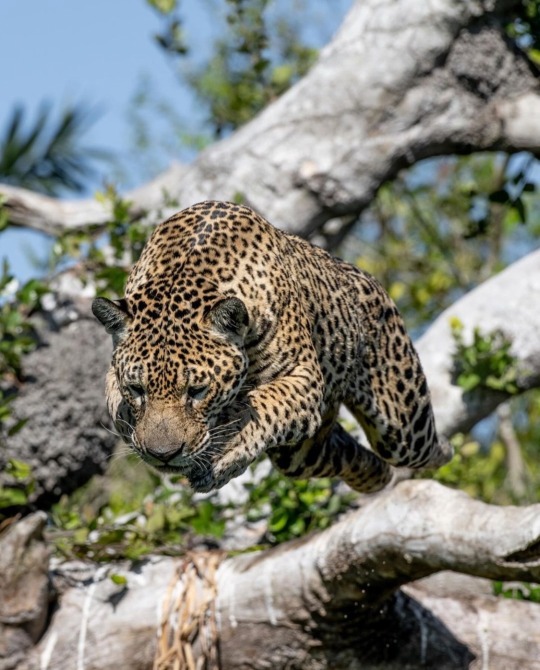
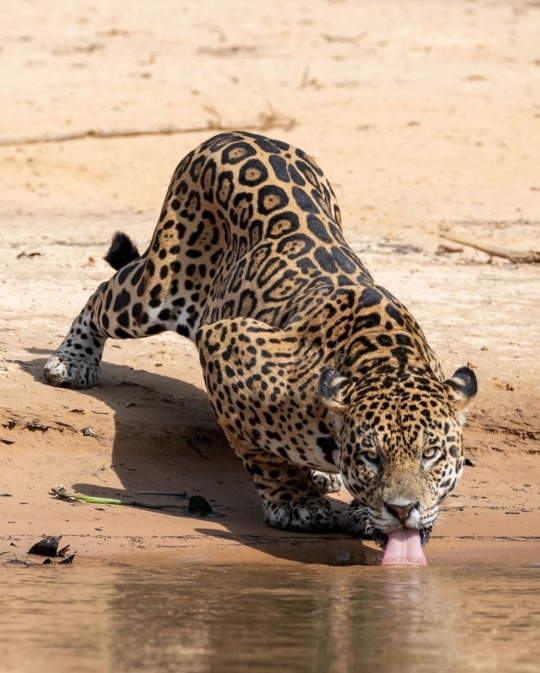

I got these from wildlife photographers on instagram
#instagram#jaguars#jaguar cats#Panthera onca#Felidae#panthers#Carnivora#felid#strong#ferocious#ferocity#cats#cheetahs#lions#tigers#leopard#carnivore#mammal#near threatened species#threatened species#wildlife#wildlife pictures#animal photography#wildlife photography#wild animals#wild and free#beautiful animals
3 notes
·
View notes
Text

It's November 5th, 🌏 World Numbat Day – a special day to honor, celebrate, and take action to conserve one of the most unique mammals on a continent full of unique mammals – Australia, of course! I bet if you aren't from Australia, you've never heard of the Numbat before, have you? Well, let me enlighten you a tiny little bit here, and maybe if we’re lucky, some more Numbat enthusiasts will enlighten us even more.
The Numbat is a very cute little endangered marsupial about the size of its more well-known cousin, the opossum. It has a long, sticky tongue perfectly evolved for devouring termites, which it feeds on exclusively – about 20,000 a day. The Numbat is under threat mainly from habitat loss and introduced predators like foxes and feral cats. With an estimated population of fewer than 1,000 animals, the Numbat desperately needs our help to ensure its survival as a species.
The Perth Zoo operates the only captive Numbat breeding program in the world. Every year, they release juveniles back into the wild into areas managed by the Department of Parks and Wildlife to boost the wild population. Everybody living in Australia can contribute directly to the Numbat conservation effort by practicing responsible pet ownership (especially cats) and by never removing hollow logs from the bush (Numbats' preferred homes). It would be such a shame to lose these adorable creatures, wouldn’t it? ☮️ Peace�� Jamiese of Pixoplanet
#Jamiese#Pixoplanet#World Numbat Day#Numbat Day#Numbat#Numbats#Ten Naughty Numbats#Nelly the Numbat#Australia#Marsupials#Perth Zoo#Australia Zoo#Steve Irwin#Bindi Irwin#Crocodile Hunter#Endangered Species#Biodiversity#Habitat Loss#Habitat Destruction#Threatened Species#Olivia Newton John#Nicole Kidman#Russell Crowe#Bee Gees#Men at Work#popular#trending#love#Project Numbat#photography
36 notes
·
View notes
Text
The Shasta Salamander complex are my favorite species of salamanders for many reasons, they were only recently split into 3 species in 2018, the Samwel Shasta salamander (Hydromantes samweli), Wintu Shasta salamander (Hydromantes wintu) and the Shasta Salamander (Hydromantes shastae).
The life history of these three species is what makes me love them so much and they all live around different parts of Lake Shasta a man-made reservoir in Northern California.
The Genus Hydromantes/Speleomantes and why they're the best
5 species exist in California while the other 8 are in Southern Europe. The two clades are thought to have separated 13.5 million years ago.
All of the species inhabit very specific habitat in limestone caves and cliffs and they all possess webbed toes for climbing steep surfaces with the help of their tail as a 5th limb. Webbed-Toed Salamanders is the common name for this Genus.
Along with being able to climb with ease these species evolved to have a ballistic tongue reaching 80% of their body length, they're the only known vertebrates to shoot part of their visceral skeleton completely out of its body as a projectile.
Back to the Shasta Salamanders
The three species were split into individual geographic areas around the lake. Due to their cryptic lifestyle in delicate habitat in a small range there was an attempt to list them as endangered species to give further protection, which was the main conflict for a $1.4 Billion project to raise the Shasta Dam that would put the salamanders at higher risk of extinction along with the remaining sacred lands (many of which were destroyed in the original construction of the dam) of the Winnemem Wintu Tribe and many other species unique to the Shasta area. The salamanders were denied the protective status.

| The range boundaries of the three species |
Last October I found out about these salamanders and I had been obsessed with them ever since and my personal adventure earlier this year to go see all three currently described species was one of the most exciting things I've ever done, I felt in touch with nature and being in the gorgeous places these unique species inhabit.
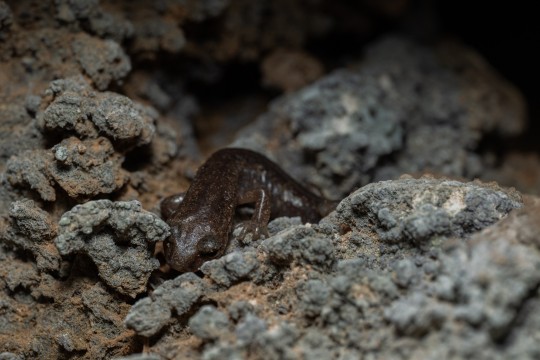
The Wintu Shasta salamander (Hydromantes wintu) was the first of the three I saw and the one I was hoping to see most. Their total range is no more than 5 km² and there's pretty much no human development along that area so I had to kayak across the lake then hike up to a cave along very steep cliffs and getting spooked by a rattlesnake during the ascent but it was well worth it to see this salamander hanging out in an eye level pocket inside the cave. Photographs were taken and then left as is to not disturb them more than needed.
The cave they were first found in was also the cave where the first Giant Short-faced Bear fossils were discovered, the largest known terrestrial mammalian carnivorians to ever exist. Many other species were described from this same cave, most being from fossils. If you're curious about visiting a more impressive cave that's much easier to reach but in the same general area go to Shasta Caverns.

The 2nd species I saw was the Shasta Salamander (Hydromantes shastae) the area I found them in was a nice walk in a Ponderosa Pine forest then immediately changed to very steep limestone cliffs (pictured below)
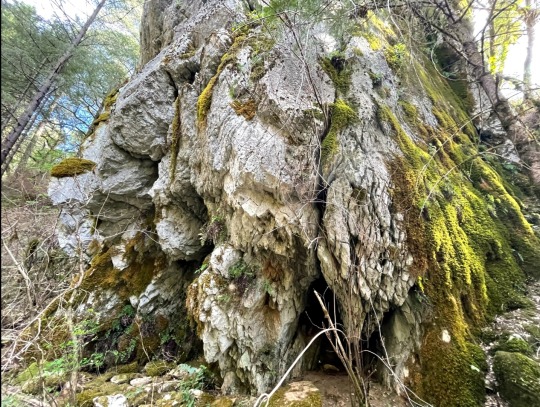
The third and final species of the complex I saw was the Samwel Shasta salamander (Hydromantes samweli)



The photos show the webbed feet the Genus is known for and notice the tail dragging behind it on the floor of the cave giving extra support, while watching all of the species walk their tail would wag back and forth helping them stay balanced.
These salamanders are very special to me and the area they inhabit and hopefully they will be able to persist with future human development and climate change. holding out hope for these little guys!!
#amphibians#salamanders#shasta#california#wildlife#wildlife photography#ecology#biology#cryptic#hydromantes#Plethodontidae#threatened species#herpetology
39 notes
·
View notes
Text
#WorldFrogDay: #DYK that over 1/3 of frog species are currently listed as threatened? That includes #1 on the plate bleow, the Giant Marsupial Frog (Gastrotheca ovifera).
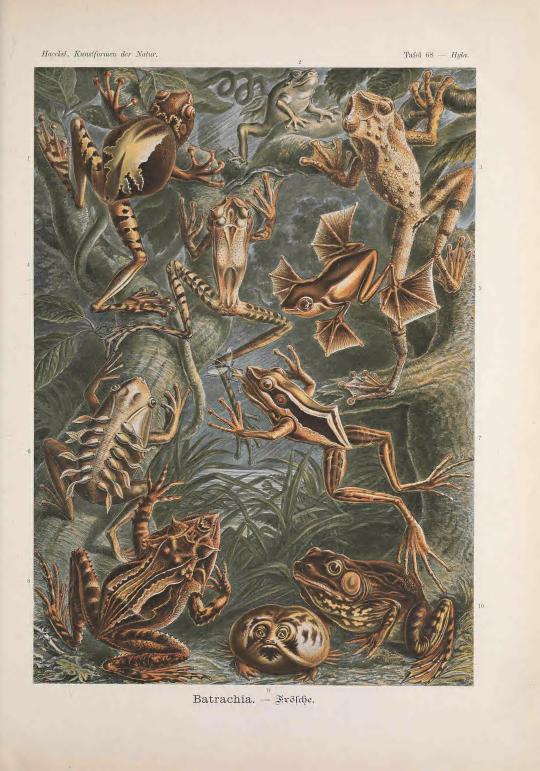
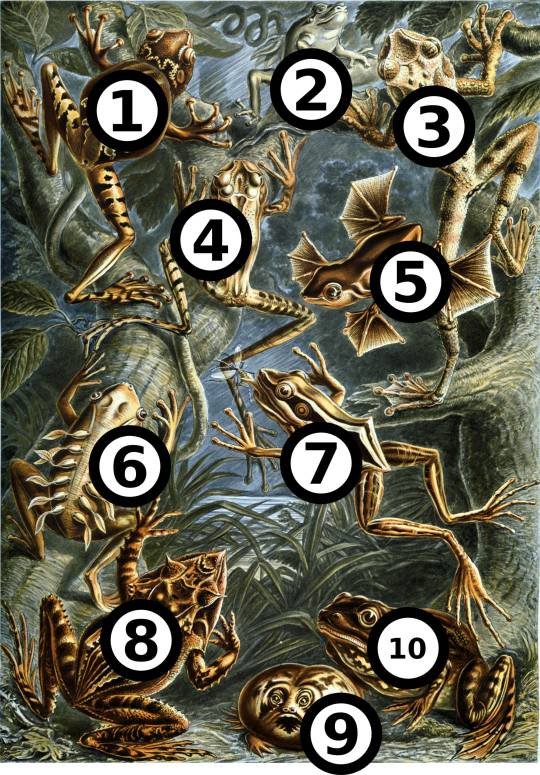
"Batrachia" Plate 68 in Kunstformen der Natur (1899-1904) by Ernst Haeckel (German, 1834-1919). Biodiversity Heritage Library.
species ID key:
1. Notodelphys ovifera (Weinland) now Gastrotheca ovifera (Lichtenstein & Weinland 1854; name revision by Rivero 1961)
2. Hyla meridionalis (Boulenger) authority usually given as (Boettger 1874)
3. Hyla tuberculosa (Boulenger) now Ecnomiohyla tuberculosa
4. Amphignathodon Güntheri or Amphignathodon guntheri (Boulenger) now Gastrotheca guentheri (Boulenger 1882; name revision by Duellman, Maxson & Jesiolowski 1988)
5. Rhacophorus pardalis (Wallace) authority usually given as (Günther 1858)
6. Hylodes lineatus (Schneider) now Craugastor lineatus (Brocchi 1879)
7. Limnodytes erythraeus (Duméril) now Hylarana erythraea (Schlegel 1837)
8. Cerathobatrachus Güntheri or Ceratobatrachus guentheri (Boulenger)
9. Breviceps mossambicus (Peters)
10.Rana pipiens (Linné) now Lithobates pipiens
#frog#frogs#amphibians#herpetology#zoology#conservation#threatened species#Ernst Haeckel#Kunstformen der Natur#20th century art#1900s#book plate#illustration#natural history art#scientific illustration#sciart#Art Nouveau#lithograph#species ID#animal holiday#World Frog Day#German art#European art#animals in art
6 notes
·
View notes
Text
#1958 - Euphorbia glauca - Shore Spurge


It was growing right next to the Mirror Bush. I’m glad @purrdence spotted it because if she’d left it a few more years it might be very difficult to find. New Zealand’s only native Euphorbia, which is surprising since the genus has a worldwide distribution and a huge number of species - over 2000.
AKA sea spurge, waiu-atua, waiū-o-Kahukura, and sand milkweed. Named for thin powdery bloom on the leaves, and Euphorbus, a Greek physician who served King Juba of Numidia in 12BC. Juba suppsedly named a cactus to honour of Euphorbus (rather unlikely to be a cactus in that part of the world - most likely one of the spiny, cactus-like Spurges) and later Linnaeus named the entire genus after the physician.
A perennial herb with multiple erect stems up to 1m tall, and underground rhizomes. Each flower, produced from October to February, is surrounded by a deep red cup-like structure with purple glands. Fruit, as here, occur from December to May. As with other Euphorbia, the sap a corrosive milky juice.
Endemic to New Zealand and the Chatham Island, growing on coastal cliffs, banks and talus slopes, sand dunes and rocky lakeshore scarps.
Cattle, sheep, pigs and possums are threats throughout the species range, mainly through browsing and trampling. Competition from taller weedy plants is significant. Coastal development such as road widening, and erosion, are further threats to most populations. Some populations on the West Coast of the South Island appear to have succumbed to a fungal disease.
2 notes
·
View notes
Text
2 notes
·
View notes
Text
Creature Awaits #195
Each week I plan to feature an amazing creature, admiring God's fantastic artistry. Hopefully it’ll brighten someone’s day to see something new and interesting if they haven’t seen it before. : )

(Excellent photograph taken by 西宁野生动物园 (CC BY-SA 3.0))
The Chinese Mountain Cat
A.K.A: The Chinese Desert Cat, The Chinese Steppe Cat
Scientific Name: Felis bieti
Region: The northeastern Tibetan Plateau
Size: About 27"-33" (~69cm-84cm) long from the tip of its nose through the end of its back, with about an 11"-16" (~29cm-41cm) tail.
Interesting Notes: Sadly, this beautiful cat has become a threatened species. Unlike many other threatened cats, instead of being hunted for their fur, etc, the primary source of harm to them comes from those attempting to cull the rampant populations of pika (a species among their favored prey) via poison. They are rarely spotted in the wild as they are not only most active at night, but prefer higher elevations along the Tibetan Plateau - roughly 8,200'-16,400' (2,500m-5,000m) above sea level.
#creatureawaits#Chinese Mountain Cat#Chinese Desert Cat#Chinese Steppe Cat#Felis bieti#beautiful cats#endangered cats#threatened species
2 notes
·
View notes
Quote
Threatened species, like the Canterbury mudfish, have no legal protection in the regulations. There’s nothing stopping somebody catching and eating them on private land, other than the fact they’re probably not good eating. Perhaps odder still, one of our ‘At Risk’ species falls into our fishery industry’s quota management system. Up to 137 tonnes of endemic long-finned eels can be caught each year. Eels only breed once in their lifetime before dying so every eel which makes it to a dinner plate or into a can of pet food, is an eel which has never had a chance to reproduce.
Farah Hancock, ‘Aotearoa’s vanishing species’, RNZ
#RNZ#Farah Hancock#Aotearoa#New Zealand#Threatened species#Canterbury mudfish#legal protection#fishery industry#quota management system#long-finned eels
4 notes
·
View notes
Text

Male golden shouldered parrot for #nationalthreatenedspeciesday we cannot lose these gorgeous parrots as they are such a rare and unique parrot species nesting exclusively in termite mounds
2 notes
·
View notes